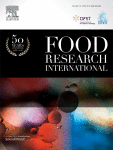Ver ítem
- xmlui.general.dspace_homeCentros e Institutos de InvestigaciónCIA. Centro de Investigaciones de AgroindustriaInstituto de Tecnología de AlimentosArtículos científicosxmlui.ArtifactBrowser.ItemViewer.trail
- Inicio
- Centros e Institutos de Investigación
- CIA. Centro de Investigaciones de Agroindustria
- Instituto de Tecnología de Alimentos
- Artículos científicos
- Ver ítem
Plum (Prunus salicina) peel and pulp microparticles as natural antioxidant additives in breast chicken patties
Resumen
Fiber microparticles (MPCs) separately obtained from peel and pulp of Japanese plum residues contained co-extracted β-carotene, lutein, and α- and γ-tocopherols, as well as polyphenols (cyanidins, quercetin derivatives, pentameric proanthocyanidins). Peel and pulp MPCs were then separately evaluated as natural antioxidant additives (2.0% w/w level) in raw breast chicken patty, susceptible to oxidation. Their effect on technological properties was also
[ver mas...]
Fiber microparticles (MPCs) separately obtained from peel and pulp of Japanese plum residues contained co-extracted β-carotene, lutein, and α- and γ-tocopherols, as well as polyphenols (cyanidins, quercetin derivatives, pentameric proanthocyanidins). Peel and pulp MPCs were then separately evaluated as natural antioxidant additives (2.0% w/w level) in raw breast chicken patty, susceptible to oxidation. Their effect on technological properties was also analyzed. MPCs reduced in 50% the formation of thiobarbituric acid reactive substances (TBARS) in raw patties during 10-days storage at 4.0 °C. Ferric reducing power (FRAP) was 77–157% higher in MPCs-added patties, especially with peel MPCs, being then attributed to the antioxidants supplied by these MPCs. It can be also associated to the highest α- and γ-tocopherol levels found in the peel MPCs-added patties, which remained high after cooking as well. Also, higher pectin and low lignin contents of pulp MPCs determined greater hydration, stabilized the cyanidins and, hence, the red color transferred to raw patties, and increased springiness of cooked patties. Plum peel and pulp MPCs are efficient additives for chicken meat products.
[Cerrar]

Autor
Basanta, Maria Florencia;
Rizzo, Sergio Anibal;
Szerman, Natalia;
Vaudagna, Sergio Ramon;
Descalzo, Adriana Maria;
Gerschenson, Lia Noemi;
Perez, Carolina Daiana;
Rojas, Ana María;
Fuente
Food Research International 106 : 1086-1094 (April 2018)
Fecha
2018-04
ISSN
0963-9969
Formato
pdf
Tipo de documento
artículo
Palabras Claves
Derechos de acceso
Restringido
 Excepto donde se diga explicitamente, este item se publica bajo la siguiente descripción: Creative Commons Attribution-NonCommercial-ShareAlike 2.5 Unported (CC BY-NC-SA 2.5)
Excepto donde se diga explicitamente, este item se publica bajo la siguiente descripción: Creative Commons Attribution-NonCommercial-ShareAlike 2.5 Unported (CC BY-NC-SA 2.5)

